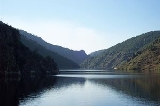
Sil River
Encyclopedia

River
A river is a natural watercourse, usually freshwater, flowing towards an ocean, a lake, a sea, or another river. In a few cases, a river simply flows into the ground or dries up completely before reaching another body of water. Small rivers may also be called by several other names, including...
in León (Castile and León
Castile and León
Castile and León is an autonomous community in north-western Spain. It was so constituted in 1983 and it comprises the historical regions of León and Old Castile...
) and Galicia, Spain
Spain
Spain , officially the Kingdom of Spain languages]] under the European Charter for Regional or Minority Languages. In each of these, Spain's official name is as follows:;;;;;;), is a country and member state of the European Union located in southwestern Europe on the Iberian Peninsula...
, a tributary of the Miño
Minho River
The Minho or Miño is the longest river in Galicia, Spain, with an extension of 340 km.Both names come from Latin Minius...
. Its total length is 225 km. The source of the Sil is in the Cantabrian Mountains
Cantabrian Mountains
The Cantabrian Mountains or Cantabrian Range are one of the main systems of mountain ranges in Spain.They extend for more than approximately 180 miles across northern Spain, from the western limit of the Pyrenees to the edges of the Galician Massif close to Galicia, along the coast of the...
in the Leonese town of Villablino
Villablino
Villablino is a municipality located in the Laciana comarca, province of León, Castile and León, Spain. According to the 2004 census , the municipality has a population of 12,212 inhabitants.-See also:*Laciana* Kingdom of León...
. It flows through the provinces of León and Ourense. The largest city on the Sil is Ponferrada
Ponferrada
Ponferrada is a city in the province of León, Castile and León, Spain. It lies on the Sil River, a tributary of the river Miño, in the El Bierzo valley, completely surrounded by mountains. It is the last major town along the French route of the Way of St. James before it reaches its destination...
(León). The Sil flows into the Miño upstream from Ourense
Ourense
Ourense is a city in northwestern Spain, the capital of the province of the same name in Galicia. Its population of 108,674 accounts for 30% of the population of the province and makes it the third largest city of Galicia.-Population:...
.
Gold deposits
The river has been a rich source of alluvial gold, and was most extensively exploited during the Roman period, following the conquest of north-west SpainSpain
Spain , officially the Kingdom of Spain languages]] under the European Charter for Regional or Minority Languages. In each of these, Spain's official name is as follows:;;;;;;), is a country and member state of the European Union located in southwestern Europe on the Iberian Peninsula...
by Augustus
Augustus
Augustus ;23 September 63 BC – 19 August AD 14) is considered the first emperor of the Roman Empire, which he ruled alone from 27 BC until his death in 14 AD.The dates of his rule are contemporary dates; Augustus lived under two calendars, the Roman Republican until 45 BC, and the Julian...
in 25 BC. The upper reaches of the river possessed large placer deposits, and the region around Las Medulas
Las Médulas
Las Médulas is a historical site near the town of Ponferrada in the region of El Bierzo , which used to be the most important gold mine in the Roman Empire...
yielded large amounts of gold. It was extracted using hydraulic mining
Hydraulic mining
Hydraulic mining, or hydraulicking, is a form of mining that uses high-pressure jets of water to dislodge rock material or move sediment. In the placer mining of gold or tin, the resulting water-sediment slurry is directed through sluice boxes to remove the gold.-Precursor - ground...
, involving the building of numerous aqueducts to expose and wash the alluvial formations.

